1. Anatomical Rudiments
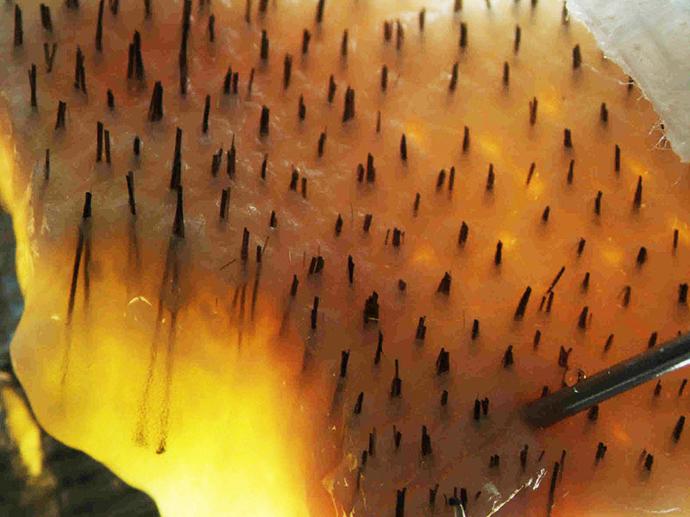
Hair grows in groups of often two, rarely one, three or four adult hairs and one or two miniaturized hairs. These natural groups are called “follicles”.
Hair grows per cycles which last between 3 and 5 years. Each hair is programmed for about thirty to fifty cycles in one life. Their diameter ranges from 60 to 100 microns, that is to say 0.1 mm. Follicles are separated from each other by 1 mm.
A hair is characterized by several variables: its colour, its texture, its length and its diameter. All these characteristics have an effect on the apparent density.
2. Embryology
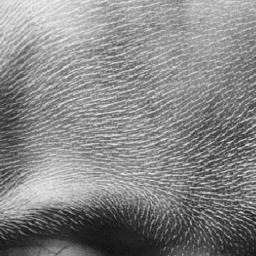
Head hair develops from hairs through a differentiation. During embryonic development, the body is covered with hairs, a very thin layer of down called ‘lanugo’.
As the foetus develops into an embryo and then a future child, hairs differentiate and progressively evolve into body hairs or head hair, according to the area they are in. It is pretty amazing to notice the broad range of body hairs a human being has. They are characterized by their shape, their texture and their length.
As far as head hair is concerned, there are differences in terms of diameter. Hair from the nape of the neck and from the temples is thinner, while hair from the donor area in the back and from sideburns is thicker. There can also be variations of texture or colour depending on the areas.
Another difference should be established – at least by patients who lose their hair – between hair sensitive to male hormones and thus likely to fall, and insensitive and resistant hair. The latter is located in what we call the donor area. It is interesting to note that their embryonic origin is different. Indeed, resistant hair is formed from a bud coming from the neck, whereas hair likely to fall is formed from a bud coming from the face. The former grows from the neck upwards and frontwards. The latter grows from the front towards the back. These two buds will then merge, a bit like two lave flows that would meet each other. The respective speed of these two growths will determine the shape and the depth of hair loss. The more the superior area is a step ahead, the larger and deeper baldness will be.
3. The Genetic Origin of Hair Loss

In 99% of cases, hair loss is the result of a genetic programming. How to be convinced of this reality? If hair loss was due to a toxicity, a lack of oxygen, an allergy or even to a deficiency of minerals or vitamins – that is to say due to a ‘general’ cause –, it would affect all the hair on the head and even the body hairs. Yet, what do we almost systematically observe? A progressive and regular evolution following a ‘pattern’ – a well-defined geography we find in many patients. We are confronted to a phenomenon which seems programmed and it is indeed so. From birth, we bear in us, hidden in the heart of our chromosomes, the genetic information that will decide the evolution of our hair.
We do not know precisely yet how many genes interfere, probably between 5 and 10, or even a dozen, but it is sure that hair loss is not due to a single gene. However, it is likely that this genetic programming is combined to an environmental effect. A series of circumstances, like stress or deficiencies, may amplify the loss at a certain period of life.
4. Evolution over Time
It is often said that hair loss breaks out at different ages. 30% of men lose their hair at 30 years old, 50% at 50, 60% at 60, and so on. A hereditary factor frequently comes into play: there is often a similarity between the severity and the evolution of hair loss observed by a patient, and those of a relative who also suffers from hair loss (a father, a grandfather, a brother, an uncle or a cousin). Unfortunately, it is impossible to predict precisely how a particular person will go bald and over what period of time. Looking for miniaturized hair enables the surgeon to determine which areas are likely to get bald.
Hair loss is first marked by a lack of volume and a loss in mass. Hair does not grow normally anymore, stays short and is light-coloured. You need to know that it is normal to have 10% of miniaturized hairs. However, in bald areas or in areas very likely to become bald, this proportion can reach between 50 and 90% of the hair.
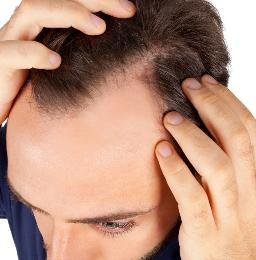
5. How Can We Follow the Evolution of Hair Loss?
It is really hard to follow objectively the evolution of hair loss. We must be very rigorous and use reliable and proven methods.
A first way consists in classifying hair losses according to their severity and their topography. The first person who defined baldness stages is Norwood. His classification system is still widely used and enables to classify oneself in an appropriate ‘stage’ in order to follow one’s evolution towards the next stage.
Unfortunately, this classification is not representative of all the types of evolution as they are far more numerous than the few major specific cases listed by Norwood.
In women, Ludwig’s classification prevails over Norwood’s one.
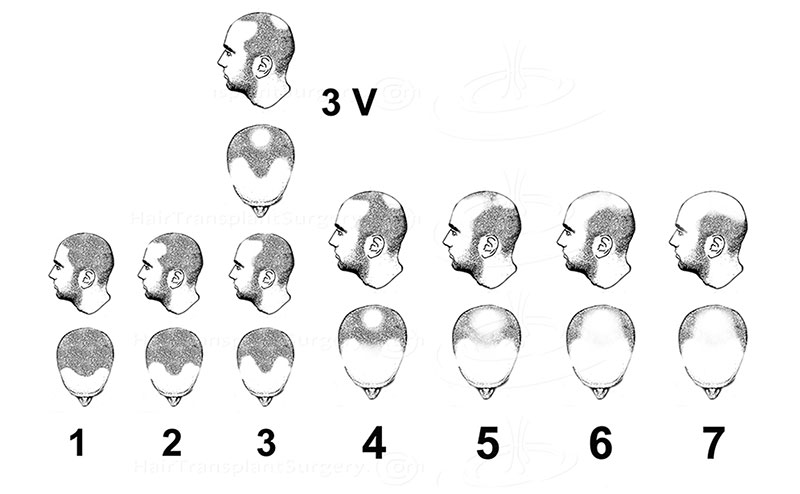
In 2004, two American colleagues, James Arnold and Bernard Cohen, imagined a system of personalised follow-up consisting in measuring precisely the ‘hair mass’ on a given surface. The system is simple: we must gather hair coming from a surface of 1 cm² in a tiny lock of hair and then measure its diameter thanks to an electronic equipment. This diameter represents thus the hair mass index at the given place.
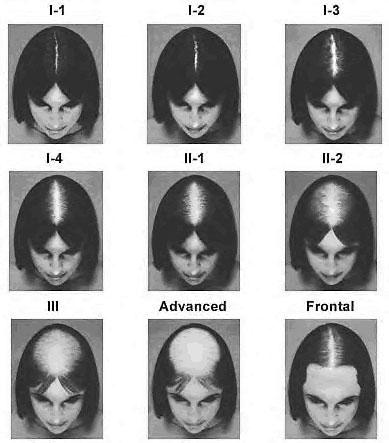
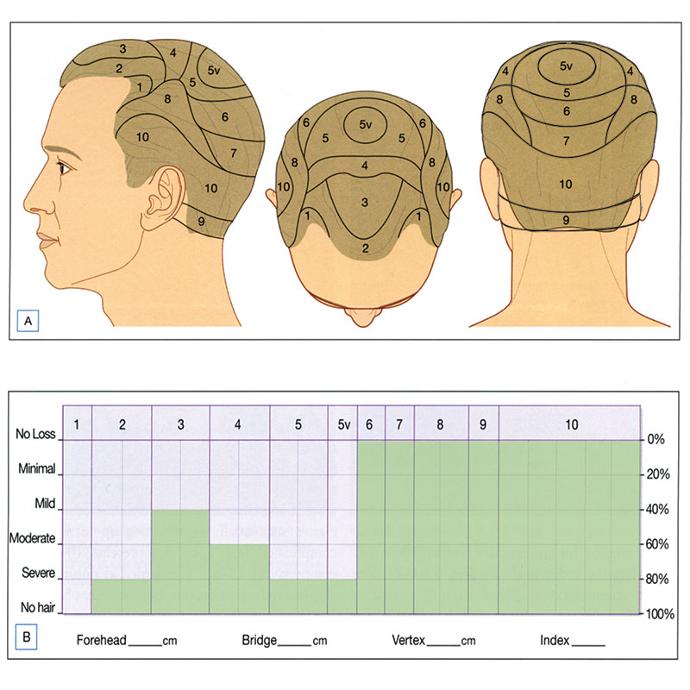
Dr. Cohen has also subdivided the scalp into 100 surface units, themselves grouped into 10 zones, each containing multiples of 5 surface units. Cohen's classification provides a precise idea of the remaining hair mass (expressed as a percentage of the original mass). To do this, for each of the 10 zones, the absolute density is measured and related to the maximum density often found in the posterior donor zone. The advantage is considerable, as this system provides a true visual profile that enables you to quickly pinpoint where the loss is greatest.
With the courtesy of Dr. Robert S. Haber. HABER, Robert S. et STOUGH, Dowling B. Classification Systems of Alopecia and Scalp Laxity. In : Hair Transplantation. Elsevier Saunders, 2006, p. 14.
These measures are long to implement but represent undeniably the best way to follow the spontaneous evolution of hair loss, as well as the result of a medication or a surgical treatment.
6. Hair, an Optical Illusion

Have you ever been in front of a forest of firs whose trunks are aligned with each other? Have you noticed that, from a distance, the wood seems dense, but when you get closer and even go inside, the feeling of density decreases? The explanation is easy: from a distance, the trunks – which are at different depths – seem to be all on the same line, they block the view and give the impression of filling all the space.
The phenomenon is perfectly similar with hair. Indeed, if we measure the ‘floor surface’ covered by hair, we notice it represents only 8 out of the 300 cm² of the scalp, barely 2.5% of the total surface.
For the mathematics lovers, here is the calculation:
Hair surface = number of hairs * surface of one hair (3.1416 * square of the radius)
S=100.000*0,05*0,05*3,1416=785 mm² = 7,85 cm²
7. Notions of Apparent Density and Actual Density

We just stated that the actual density is actually extraordinarily low in comparison with the impression of density it gives. Even more impressive: it is possible to reduce the original actual density by 40%, without seeing any difference. This is called the apparent density.
We tend to say that the apparent density remains stable for many years, even if the actual density dwindles with hair fall. That is what actually happens in the anterior area during the first period of hair loss: the patient notices a hair loss or a loss in mass, but his family circle does not see anything and often reassures the patient by evoking an imaginary loss…
This notion is crucial and explains why a hair transplant is possible. A hair transplant consists in a transfer, in a more harmonious redistribution of the hair mass.
The actual density is expressed as a number of hairs per cm², or even as a hair mass per cm². This is then an objective value that can be measured. The apparent density, however, is a subjective value, an impression. This is the result of an optical illusion. It depends on a series of factors linked to hair and the underlying skin.
As it is possible to keep a good apparent density in the donor area while removing hair two or three times, we can then consider transplanting hair in the recipient area and obtaining a good apparent density there too, even if we reach only a fraction of the original density (between 30 and 50%).